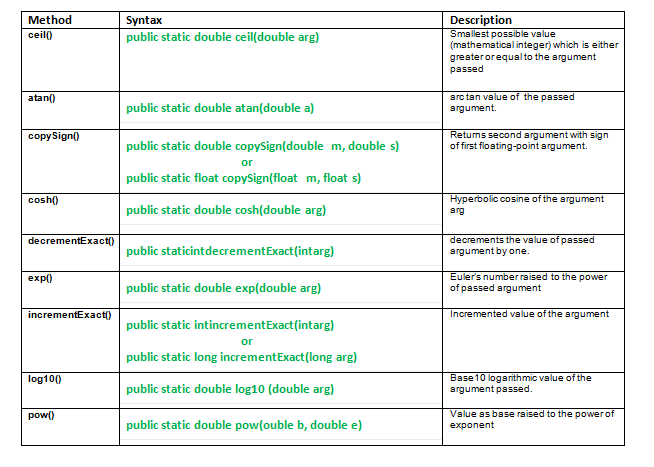java.math class and its methods | Set 3
Last Updated :
19 Aug, 2021
java.math class and its methods | Set 1
java.math class and its methods | Set 2

- ceil() : java.math.ceil(double a) method returns the smallest possible value which is either greater or equal to the argument passed. The returned value is a mathematical integer.Special Case :
- Result is same, if the returned value is already a mathematical integer.
- Result is same, if the passed argument is NaN or infinite or zero.
- Result is negative zero, if the passed argument is less than zero but greater than -1.0
Syntax:
public static double ceil(double arg)
Parameters:
arg - the argument value
Returns:
smallest possible value(mathematical integer)
which is either greater or equal to the argument passed
- atan() : java.math.atan() method returns the arc tangent of the method argument value. The returned angle is in the range -pi/2 through pi/2.
arc tan is inverse tan of the argument passed.
atan(arg) = tan inverse of arg
Special Case :
- Result is NaN, if the passed argument is NaN or its absolute value is > 1.
- Result is zero, if argument is zero.
Syntax:
public static double atan(double a)
Parameters:
a - the argument whose arc tangent value we need.
argument is taken as radian
Returns:
arc tan value of the argument.
- copySign() : java.math.copySign() method returns first floating-point argument but having the sign of second argument.
Syntax:
public static double copySign(double m, double s)
or
public static float copySign(float m, float s)
Parameters:
m - magnitude
s - sign
Returns:
returns second argument with sign of first floating-point argument.
Java code explaining atan(), ceil(), copySign() method in Math class.
Java
import java.math.*;
public class NewClass
{
public static void main(String[] args)
{
double Atani = Math.atan(0);
System.out.println("atan value of Atani : "+Atani);
double x = Math.PI/2;
x = Math.toRadians(x);
double Atanj = Math.atan(x);
System.out.println("atan value of Atanj : "+Atanj);
System.out.println("");
double val = 15.34 ,ceilval;
ceilval = Math.ceil(val);
System.out.println("ceil value of val : "+ceilval);
System.out.println("");
double dblMag = val;
double dblSign1 = 3;
double dblSign2 = -3;
double result1 = Math.copySign(dblMag,dblSign1);
System.out.println("copySign1 : "+result1);
double result2 = Math.copySign(dblMag,dblSign2);
System.out.println("copySign2 : "+result2);
}
}
|
Output:
atan value of Atani : 0.0
atan value of Atanj : 0.0274087022410345
ceil value of val : 16.0
copySign1 : 15.34
copySign2 : -15.34
- cosh() : java.math.cosh() method returns the hyperbolic cosine of the argument passed.
Special cases :
- Result is NaN, if argument is NaN.
- Result is 1.0, if the argument is zero.
- Result is +ve infinity if the argument is infinite.
Syntax:
public static double cosh(double arg)
Parameters:
arg - The number whose hyperbolic cosine is to be returned.
Returns:
the hyperbolic cosine of the argument arg.
- decrementExact() : java.math.decrementExact() method decrements the value of passed argument by one.
Syntax:
public static int decrementExact(int arg)
or
public static long decrementExact(long arg)
Parameters:
arg - argument passed.
Returns:
return argument decremented by one.
Throws:
Exception if the result overflows long or int datatype, according to the
argumented data type.
- exp() : java.math.exp(double arg) method returns the Euler’s number raised to the power of double argument.
Important cases:
- Result is NaN, if argument is NaN.
- Result is +ve infinity, if the argument is +ve infinity.
- Result is +ve zero, if argument is -ve infinity.
Syntax:
public static double exp(double arg)
Parameters:
arg - argument passed.
Returns:
Euler’s number raised to the power of passed argument
Java code explaining exp(), decrementExact(), cosh() method in Math class.
Java
import java.math.*;
public class NewClass
{
public static void main(String[] args)
{
double value = 2;
double coshValue = Math.cosh(value);
System.out.println("Hyperbolic Cosine of " + coshValue);
System.out.println("");
int result = Math.decrementExact(3051);
System.out.println("Use of decrementExact() : " + result);
System.out.println("");
double exponent = 34;
double expVal = Math.exp(exponent);
System.out.println("Value of exp : "+ expVal);
}
}
|
Output:
Using addExact() : 9
acos value of Asini : NaN
acos value of Asinj : 0.054858647341251204
cube root : 6.0
- incrementExact() : java.math.incrementExact() method returns the argument by incrementing it’s value.
Syntax:
public static int incrementExact(int arg)
or
public static long incrementExact(long arg)
Parameters:
arg - the argument
Returns:
incremented value of the argument
- log10() : java.math.log10() method returns the base10 logarithmic value of the passed argument.
Syntax:
public static double log(double arg)
Parameters:
arg - argument passed.
Returns:
base10 logarithmic value of the argument passed.
- pow() : java.math.pow(double b, double e) method returns the value as be
Syntax:
public static double pow(double b,double e)
Parameters:
b : base
e : exponent
Returns:
value as baseexponent
JAVA code explaining incrementExact(), log10(), pow() method in Math class.
Java
import java.lang.*;
public class NewClass
{
public static void main(String[] args)
{
int f1 = 30, f2 = -56;
f1 =Math.incrementExact(f1);
System.out.println("Incremented value of f1 : "+f1);
f2 =Math.incrementExact(f2);
System.out.println("Incremented value of f2 : "+f2);
System.out.println("");
double value = 10;
double logValue = Math.log10(value);
System.out.println("Log10 value of 10 : "+logValue);
System.out.println("");
double b = 10, e = 2;
double power = Math.pow(b,e);
System.out.println("Use of pow() : "+power);
}
}
|
Output:
Incremented value of f1 : 31
Incremented value of f2 : -55
Log10 value of 10 : 1.0
Use of pow() : 100.0
Note: There is no need to create a new object in order to call these methods as the above discussed Math class methods are static.
Share your thoughts in the comments
Please Login to comment...